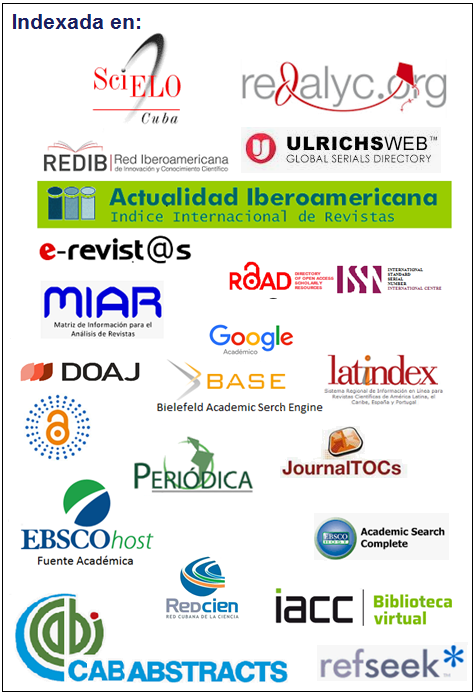Validation of Au grade estimation models in a sector of the Golden Hill deposit
Keywords:
model validation, estimation models, Au grade, Geostatistical simulation, tonnage-grade curves, Golden Hill goldfield.Abstract
Validation of grade estimation models in the mineral resource estimation process guarantees the quality and reliability of results and the correct definition of mineral reserves in the most objective mining planning possible. This research presents the results of the validation of Au grade estimation models in Three Hills sector of the Golden Hill gold deposit (Las Tunas province), used as a case study. We worked with the information obtained in the detailed exploration and exploitation exploration campaigns, as well as with the estimation models of the Au grade; these models were compared with the standard curves of grade, tonnage and metal quantity, obtained by Geostatistical simulation for 10 simulated equiprobable Au grade scenarios. A procedure is proposed that allows validating the Au grade estimation models in similar deposits, based on the loss or excess of the amount of metal between the tonnage-grade curves, those obtained in the estimation models in two moments (stages 1 and 2) of exploitation exploration and the average predictive standard curves of simulated grade, tonnage and amount of metal. It is shown that stage 1 model should not be considered for defining gold resources, since it undervalues the estimates, although the stage 2 model is close to the simulated pattern-curves, it must also be reworked.Downloads
References
Abzalov, M. 2016: Applied Mining Geology. Vol. 12. Springer Nature.
Arias del Toro, J. A. 2008: Influencia de la red de exploracion en la determinacion del potencial recuperable de menas lateriticas niqueliferas en un sector del yacimiento Pinares Oeste. Tesis de Maestría. Universidad de Pinar del Rio Hermanos Saiz Montes De Oca.
Arisaca, J. E. 2012: Metodologías de validación para modelos de recursos. MineSight Applications Perú S.A.C.
Deutsch, C. V. y Journel, A. G. 1998: Geostatistical Software Library and User's Guide. Second Edition. Oxford University Press.
Freites, J. G. 2016: Herramientas para validar el modelo de bloques interpolado. Consulta: 18/05/2019. Disponible en: http://www.cursosgeomin.com.ve/herramientas-validar-modelo-bloques-i.
Journel, A. G. y Huijbregts, C. J. 1978: Mining Geostatistics. Centre de Geostatistique Fontainebleau, France: Academic Press.
Lopes, J. A.; Fernandes, J. B. y Vanzela, G. A. 2011: Risk Quantification In Grade-Tonnage Curves And Resource Categorization. In A Lateritic Nickel Deposit Using Geologically Constrained Joint Conditional Simulation. Journal of Mining Science, 47.
López-Kramer, J. M.; Pimente-Olivera, H.; Arce-Blanco, M.; Pérez-Aragón, R. O.; Santa Cruz-Pacheco Sarlabous, M.; Peñalver-Hernández, L. L. y Gallardo-Eupierre, E. 2021: Los Gossans con Oro y Plata del Archipiélago Cubano. La Habana: Instituto de Geología y Paleontología.
Pincock, A. H. 2010: How Good Are Your Resource (Block) Model Estimates? Pincock Perspectives Issue 102.
Remy, N.; Boucher, L. y Wu, I. 2009: Applied geostatistics with sgems a user’s guide. New York: Cambridge university press.
Rossi, M. E. y Deutsch, C. V. 2014: Mineral Resource Estimation. New York-London: Springer Dordrecht Heidelberg.
Sama, A. R. 2016: Validation of resource model and improving confidence. Consulta: 18/05/2019. Disponible en: https://www.linkedin.com/pulse/validation-resource-model-improving.
Vila-Placeres, G.; Guilarte-Lores, E.; Sánchez-Silva, Y.; Carmenates-Nieves, H.; Martínez-Mejías, M.; Espinosa-Labrada, R. y García-Quintana, D. 2018: Informe de Exploración de Explotación UEB Oro Golden
Published
How to Cite
Issue
Section
- Authors retain copyright and guaranteeing the right magazine to be the first publication of the work as licensed under a Creative Commons Attribution-NonCommercial that allows others to share the work with an acknowledgment of the work's authorship and initial publication in this journal.
- Authors may establish separate supplemental agreements for the exclusive distribution version of the work published in the journal (eg, place it in an institutional repository or publish it in a book), with an acknowledgment of its initial publication in this journal.
- Authors are allowed and recommended to disseminate their work through the Internet (e.g., in institutional telematic archives or on their websites) before and during the submission process, which can produce interesting exchanges and increase citations of the published work. (See The effect of open access)



